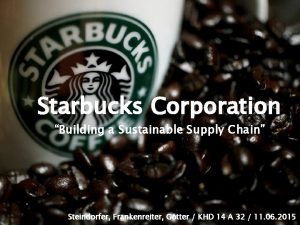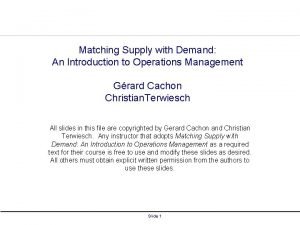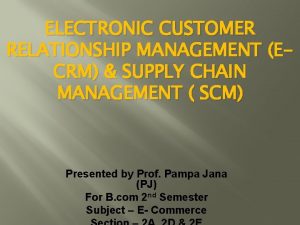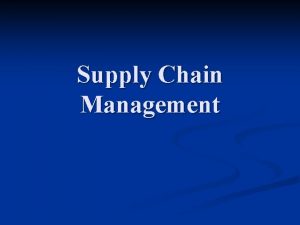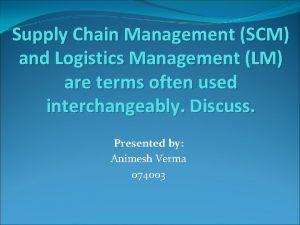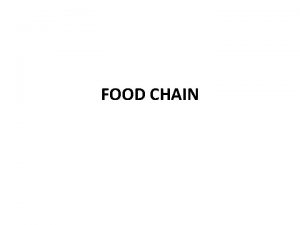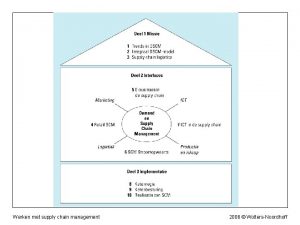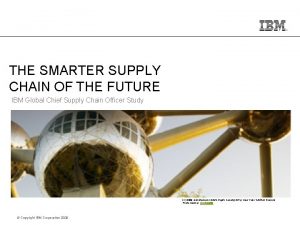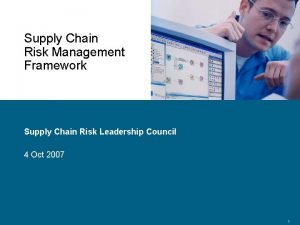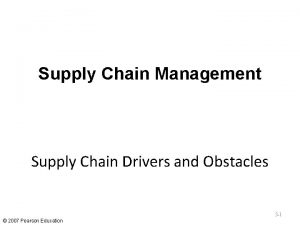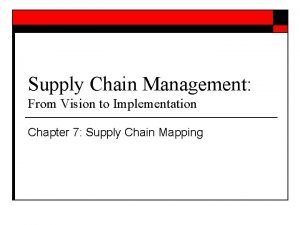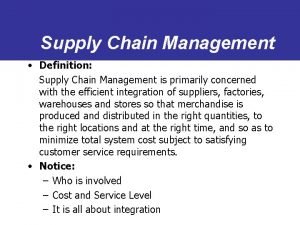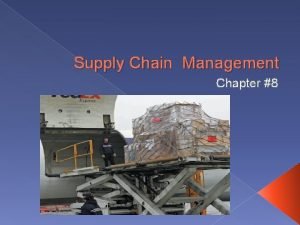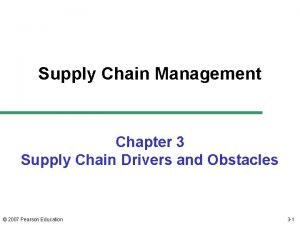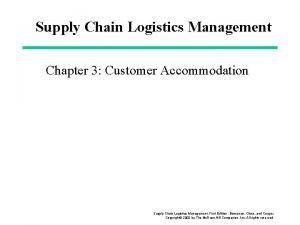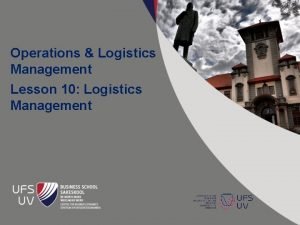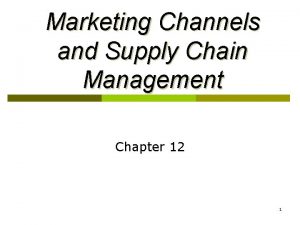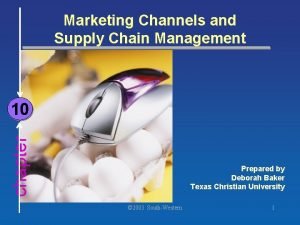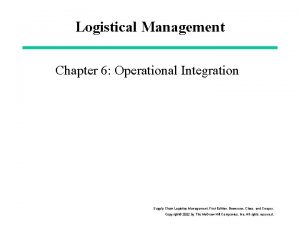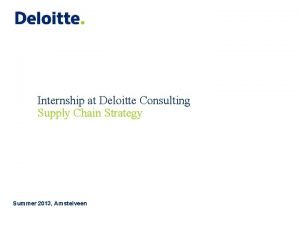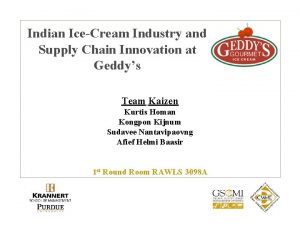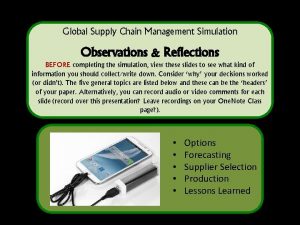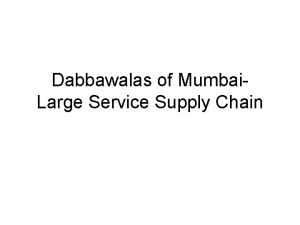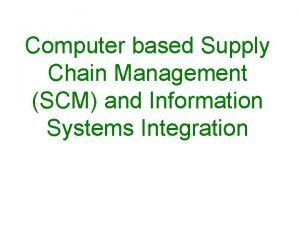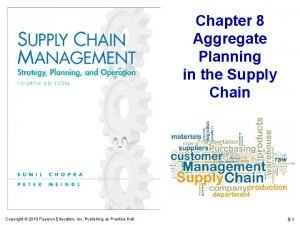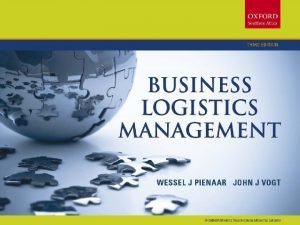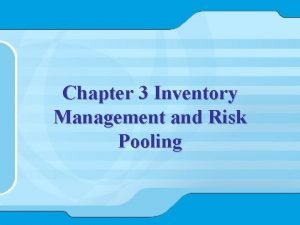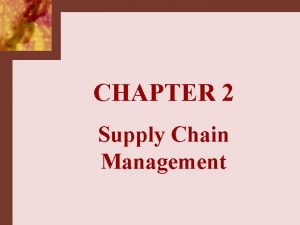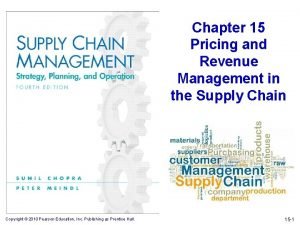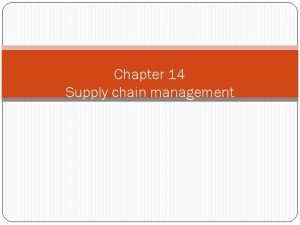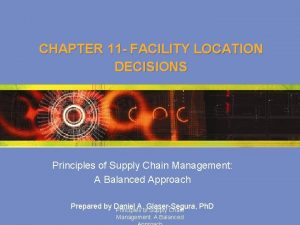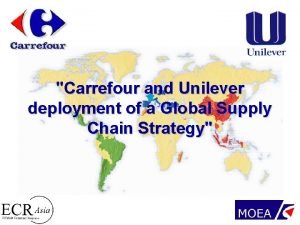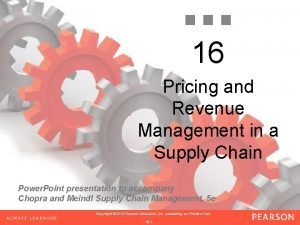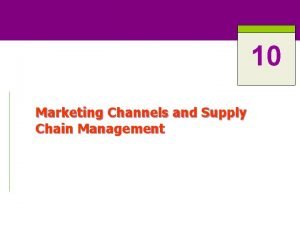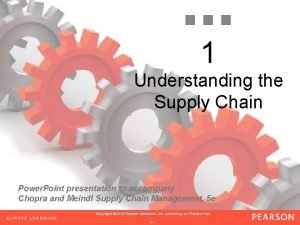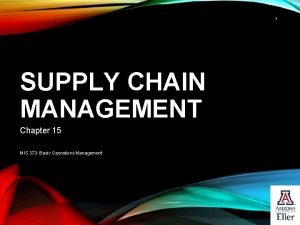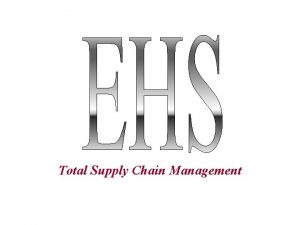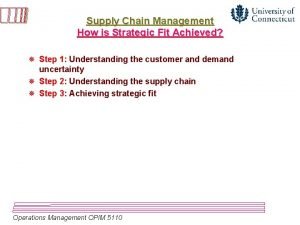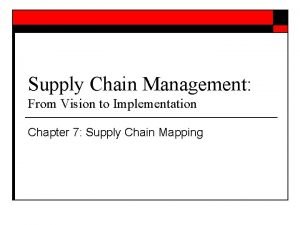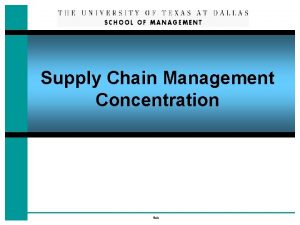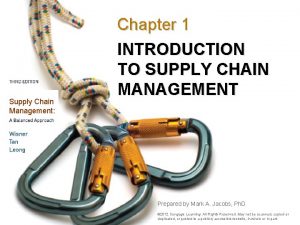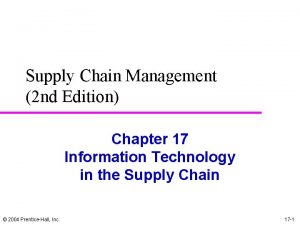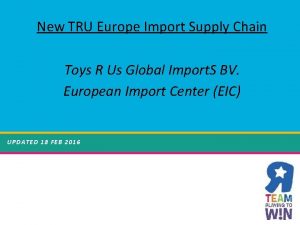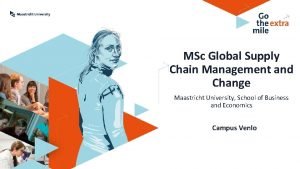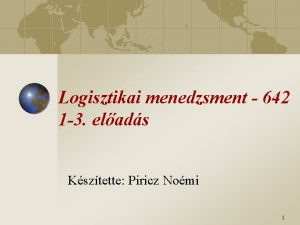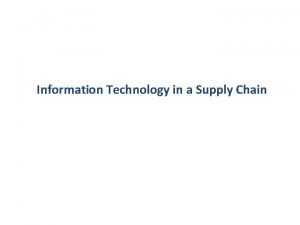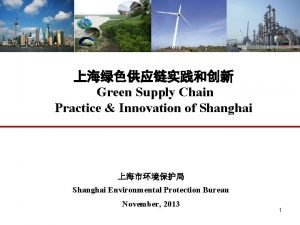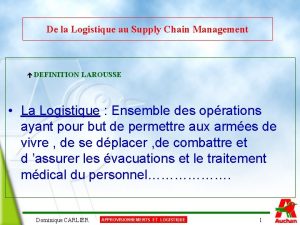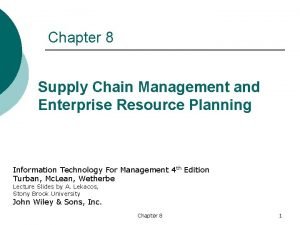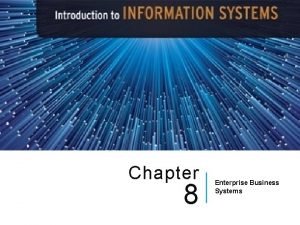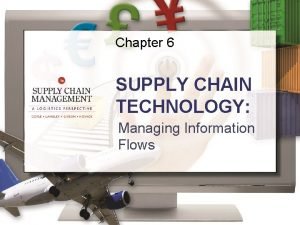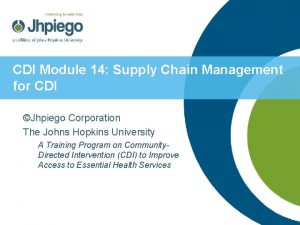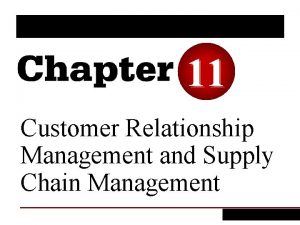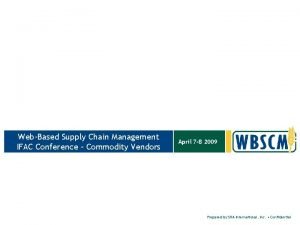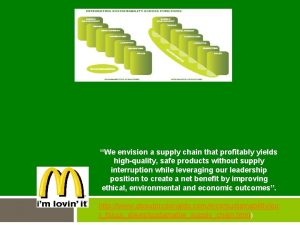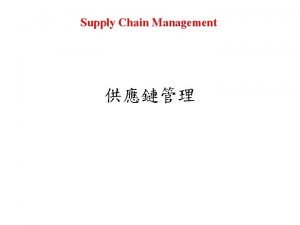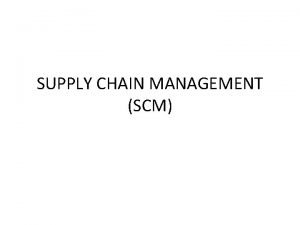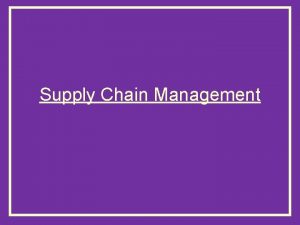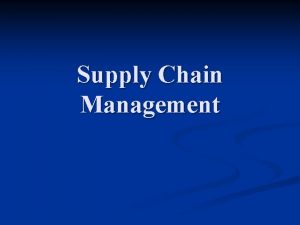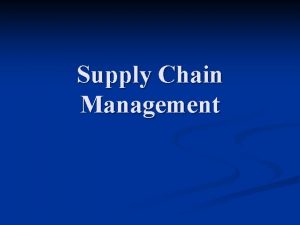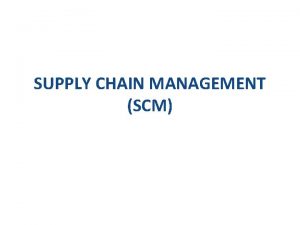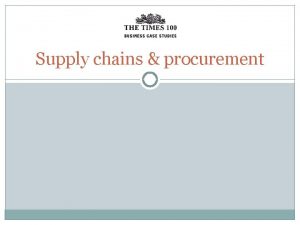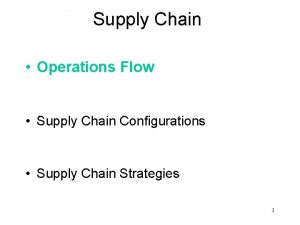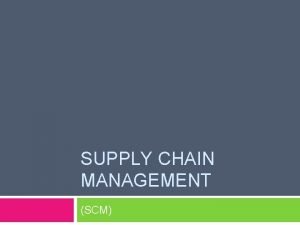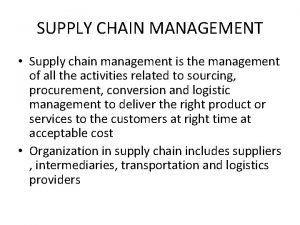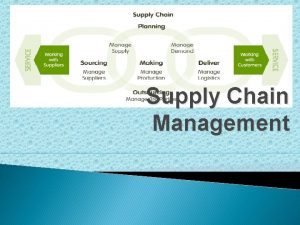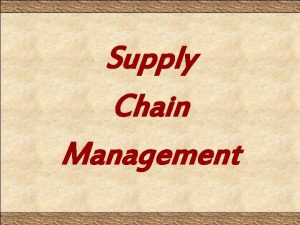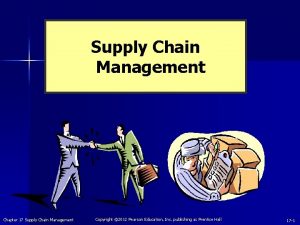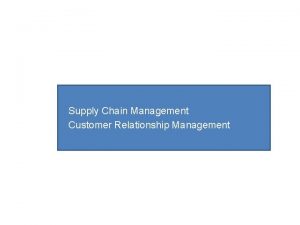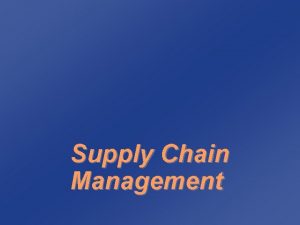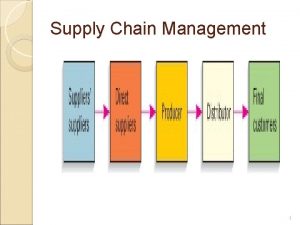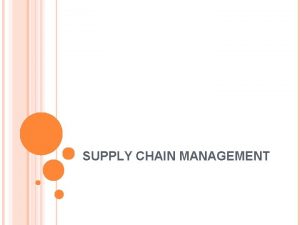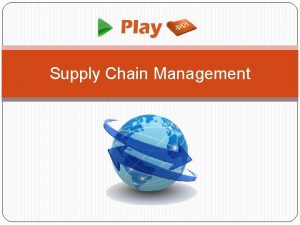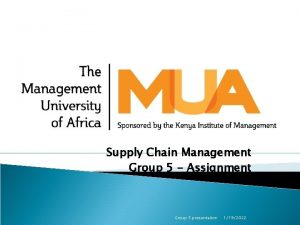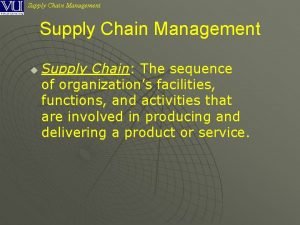Supply Chain Management Sustainable Supply Chain Management 2

Supply Chain Management Sustainable Supply Chain Management

2

n n n n Supply Chain Responsiveness Supply Chain Partnering Global Supply Chain Risks Management Supply Chain Mitigations Supply Chain Quality Management Sustainable Supply Chain Green Supply Chain Lean Supply Chain Service Supply Chain Security Supply Chain Tourism Supply Chain Halal Supply Chain 3

n Discuss the concept of supply chain, n Define the concept of sustainability within the context of supply chain management, and n Determine how firms and their supply chains can most likely achieve long lasting success even if their operating environment becomes hostile. 4

Theory of Supply Chain Management Companies seek to design business models that meet customer needs better than competitors. Success depends on the ability to Design, Make, and Deliver innovative, high quality, low cost products and services that customers demand. 5

Theory of Supply Chain Management n Supply chain management allows companies to focus on their unique skill sets. n Supply chain management requires a common understanding of supply chain objectives and individual roles, an ability to work together, and a willingness to adapt in order to create and delivery the best products and services possible. 6

Supply Chain: Manufacturing Example 7

Supply Chain: Manufacturing Example 8

Supply Chain: Service Example 9

Supply Chain: Service Example 10

Supply Chain Management Defined Supply chain management is the design and management of seamless, value-added processes across organizational boundaries to meet the real needs of the end customer. - Institute for Supply Management 11

Supply Chain Integration n Internal Process Integration: increase collaboration among the company’s functional groups. n Backward Process Integration: collaboration with 1 st -tier and 2 nd-tier (leading companies) suppliers. n Forward Process Integration: collaboration with 1 sttier customers. n Complete Integration: collaboration from the “suppliers’ supplier to the customers’ customer. ” 12

Supply Chain Integration Common 13

Internal Value Chain Elements n Executive Management defines company strategy and allocates resources to achieve it. n Supply Management coordinates the upstream supply base, finding the right suppliers and building the right relationships with them. n Operations transforms the inputs acquired from suppliers into more highly valued products. n Logistics moves and stores materials so they are available when and where they are needed. n Marketing manages the downstream relationships with customers, identifying their needs and communicating to them how the company can meet those needs. 14

Internal Value Chain Elements n Human Resources designs the systems used to hire, train, and develop the company’s employees. n Accounting maintains business records that provide information needed to control operations. n Finance acquires and controls the capital required to operate the business. n Information Technology builds and maintains the systems needed to capture and communicate information among decision makers. n Research and Development (R&D) is responsible for new product design. 15

Internal Value Chain: Local Focus Executive Management R&D Information Technology Operations Supply Management Logistics Marketing Finance Accounting Human Resource Management 16

Internal Value Chain: Company Focus Executive Management R&D Information Technology Upstream Suppliers Operations Supply Management Logistics Downstream Customers Marketing Finance Accounting Human Resource Management 17

Internal Value Chain: Company Focus Executive Management R&D Information Technology Upstream Suppliers Operations Supply Management Logistics Downstream Customers Marketing Finance Accounting Human Resource Management 18

SCM: Linked Value Chains Executive Management R&D Information Technology Operations Supply Logistics Management Supply Management Finance Accounting Human Resource Management Supplier’s Supplier Executive Management R&D Information Operations Technology Supply Management Operations Logistics Marketing Accounting Human Resource Management Executive Management R&D Information Operations Technology Information Technology Supply Management Logistics Management Operations Logistics Finance Marketing Finance Accounting Human Resource Management Finance Marketing Supplier Focal Human Customer Resource Accounting Firm Management Marketing Accounting Human Resource Management Customer’s Customer 19

Supply Chain Management Problems n The goal of supply chain management is to use technology and teamwork to build efficient and effective processes that create value for the end customer. n The goal is compromised when processes, value chain elements, and/or companies work toward local rather than global optimum. 20

The Bullwhip Effect n Variation in demand is exaggerated as information moves upstream away from the point of use. n Variation in demand is exaggerated due to infrequent demand and/or inventory level information exchange and order batching. 21

The Bullwhip Effect 22

The Bullwhip Effect n Bullwhip effect costs can be as high as 12 to 25% n Bullwhip can be effectively mitigated by: n Sharing point of sale data n Collaborative forecasting n Collaborative future product promotion planning 23

Integrating SCM and Strategy What makes Dell and Wal-Mart successful? It’s the business model, and supply chain is an enabler. That’s why you’re seeing this growing importance of supply chains. People realize this is the weapon of the future. - Robert W. Moffat Jr. , IBM 24

Strategy n Strategy is the basis from which a consistent allocation of resources is made to achieve some objective. n The objective of “for-profit” organizations is to make money; the best way to achieve this objective may be to focus on satisfying the customer. 25

Contingency Theory n Contingency theory recognizes the need for managers to consider the relationship between a changing environment, managerial decisionmaking, and performance. n Situational awareness is key to effectively aligning company resources in a changing competitive environment. 26

Industrial Organization Theory n Market forces constrained by the power of suppliers, buyers, existing rivals, potential rivals, and providers of substitute products/services should drive decisionmaking. n Industrial Organization core questions: 1. Where does market power exist? 2. What are the sources of that power? 27

Resource-Based Theory n Resource-based theory emphasizes management of internal sources to establish a unique skill set. n Unique skills/processes (core competence) lead to competitive advantage, the ability to deliver distinctive products/services in a way that adds value in the eyes of the customer. 28

Four Decision Areas for Strategy 1. Environment n Internal – company culture, functional relationships, reward and measurement system n External – competitive, economic, legal, and political environments 29

Environmental Considerations 30

Four Decision Areas for Strategy 1. Environment n Internal – company culture, functional relationships, reward and measurement system n External – competitive, economic, legal, and political environments 2. Resources – all assets a firm can bring to bear, including: people, technology, infrastructure, materials, and money. n Success requires investment in knowledge and processes 31

Four Decision Areas for Strategy 3. Objectives – unifies decision-making throughout a company. n Focusing on the right objectives is the key to a winning business strategy. 4. Feedback –input to the control mechanism, insuring the company strategy adapts to a changing competitive environment. n Marketplace – custom expectations, company capabilities, and competitor actions n General – exchange rates, government policies, technologies, weather and other natural occurrences 32

Strategic Thinking: Traditional View A valid business model must answer two questions: 1. What is our business? n Who are our customers? n What is the real value that we offer them? 2. How can we do it better than anyone else? n Unique organizational capabilities n Almost always process based 33

Supply Chain Strategy n Seeks to leverage the resources and skills of diverse companies in the supply chain to deliver exceptional value to the end customer. n Addresses: n How the capabilities of other chain members can be used to create value for the end customer n How their own strategy and actions impact the ability of the supply chain to create value for the end customer 34

Supply Chain Strategy Rather than “What is our business? ” the SC strategist inquires: n What is the overall supply chain’s value proposition? n How does our company uniquely help the chain deliver on its value proposition? 35

Supply Chain Strategy Rather than “How can we do it better than anyone else? ” the SC strategist asks: n What valued capabilities do other members of the chain possess? n How can we bring these complementary competencies together in a way customers value? n What type of relationships should we maintain with other members of the supply chain? n Are any customer-valued competencies missing? If so, who is best positioned to develop them? n How much of the value-added process should we control? 36

37

What is Sustainable Business? n To some it is “triple bottom line” reporting – economic, social and environmental. n Put simply, it is: “future-proofing your business”

What is Sustainable Supply Chain? n Resources are consumed in line with replenishment patterns n General business decisions consider long-term business interruption impacts n Total Risk and costs continue to fall over time. n This is not JUST an environmental issue

Sustainable Supply Chain n Sustainable supply chain management (SSCM) is the strategic, transparent integration and achievement of an organization’s social, environmental, and economic goals in the systemic coordination of key inter-organizational business processes for improving the long-term economic performance of the individual company and its supply chains (Carter & Rogers, 2008, International Journal of Physical Distribution and Logistics Management, Volume 38, Number 5). 40

41

Intersections Of Economic With Social And/Or Environmental Performance n n Cost savings due to reduced packaging waste (Mollenkopf et al. , 2005; Rosenau et al. , 1996), and the ability to design for reuse and disassembly (Christmann, 2000; Hart, 1995; Shrivastava, 1995 c). Reduced health and safety costs, and lower recruitment and labor turnover costs -resulting from safer warehousing and transportation and better working conditions (Brown, 1996; Carter et al. , 2007). Lower labor costs – Better working conditions can increase motivation and productivity, and reduce the absenteeism of supply chain personnel (Holmes et al. , 1996; Mc. Elroy et al. , 1993). Proactively shaping future regulation – companies that proactively address environmental and social concerns can influence government regulation when this regulation is modeled after a company’s existing production and supply chain processes, leading to a difficult-to-replicate competitive advantage for companies and their suppliers (Carter and Dresner, 2001). 42

n n Reduced costs, shorter lead times, and better product quality - associated with the implementation of ISO 14000 standards, which provide a framework for environnemental management systems (Hanson et al. , 2004; Montabon et al. , 2000; Tibor and Feldman, 1996). Enhanced reputation – engaging in sustainable behavior can make an organization more attractive to suppliers and customers (Ellen et al. , 2006), to potential employees (Capaldi, 2005), and to shareholders (Klassen and Mc. Laughlin, 1996). 43

…. And Just Why Do We Want One? n Making profits for a while isn’t particularly difficult. The challenge is to do it sustain-ably. n If we consume more resources than the total system can deliver to us, then other resources will be wasted waiting for the late ones. Wastage = Financial loses.

Sustainability…. . Why? ? n To reduce costs…energy n To reduce risk…waste bills, water shortages n To reduce absenteeism…less toxins, cleaner air n To improve productivity…natural light and ventilation n To increase property value…low operating costs n To create healthier environments…landscaping. n To lead…staff and students n To Increase profits – on an ongoing basis …. .

So, what is the problem…? n Humans are the only species on earth that create waste n We are using the earths resources faster than they can be replenished n We are creating substance that nature can not manage…can not break down n We are destroying the earths bio-diversity at an increasingly fast pace n With 80% of the planets resources and 80% of the planets wealth sitting in the hands of just 20% of the worlds population…we are not being fair to all people. n We are consuming and living way beyond the means of this one…finite planet.

SCM Risk – What should we think about? n Who am I dependent on? n Which systems are critical and which are not? n What could take me down, and how long would the outage last? n What contingencies does my business have in place? n What contingencies do my suppliers have in place? - Lisa Hauser, Marsh Consulting

Many Companies believe that it is necessary to achieve sustainability across their supply chains. So why isn’t it happening?

Why the lack of emphasis n With basic environmental management processes achieved – there is little low hanging fruit left. n Consumers often do not see it as a benefit worth supporting and driving n Short term focus of user, consumer, management or government

So what can you do? n As a consumer and a professional, give emphasis on sustainable options. n Create transparency across your entire supply chain n Convert everything to dollars where you can…. . an example is the reaction of fast food companies to potential “Fat Tax” (you pollute you pay) movements !!

So what can you do? n Encourage your company members through brainstorming sessions, project teams and feedback loops. n Encourage suppliers to become more sustainable; be a watchdog. n Educate your customers so they see that your sustainability could result in fewer interruptions to their supply – this would give your organisation a competitive advantage.

So what can you do? n There is a world-wide shortage of skills. n Why? n Because we are not committed to training. We need to train more to ensure that the workforce is sustainable.

The Process of Improvement n Step One – Culture n Step Two – Evaluate your organisation and your suppliers n Step Three – Get the right people involved n Step Four – Make SMART Plans – include reporting processes and formats n Step Five – Take Action n Step Six – Measures/Evaluation/review progress n Step Seven - Benchmark

There are seven steps that companies can take in order to become sustainable 1. 2. 3. 4. 5. 6. 7. The first step is culture. The second step to instituting sustainability within a corporation is to educate the organization on sustainability. It is imperative to show employees the benefits of sustainability and what it can do for a company and our environment. The third step on our journey to sustainability is to complete a sustainability audit of our company’s supply chain. We need to develop a baseline measure for where we are today in order to gauge where we need to go. Determining the goals and objectives for the sustainable supply chain. When developing goals and objectives, companies must make sure their goals are SMART (Specific, Measurable, Attainable, Relevant, and Timely) and that they are focused on sustainability. Fifth step would be to determine what actions need to take place in order to meet these objectives. Measures must be in taken in order to see how effective we are with our projects. These sustainability measures must be posted and discussed at company meetings. Measuring objectives will drive results! Once we reach a measure we need to raise the bar and focus on getting more sustainability within our supply chain processes. If we are falling short of our measures we need to find out what is preventing us from reaching our goals? Benchmark where your company is in regards to sustainability. Even though we have goals, and have projects and measures in place, we need to seek out other companies that are trying to achieve sustainability. What are they doing that we can incorporate in our organizations? How can we replicate and incorporate their successful sustainability initiatives? We need to leverage the learning that is occurring in other companies and incorporate it into our organizations, which in turn will benefit society.

Case Study One – Palliser Estate n Committed to achieving Zero Waste. n Vineyard waste from pruning is mulched and left to break down between the grapevine rows. Under vine areas are mown rather than sprayed. n "We are organic in style as much as possible" says Sharon Goldsworthy, "but we must reserve the right to go in with a spray if there is no other option and we may lose our crop. The reality is sometimes different from theory. “ n Other things the judges liked: n n n n Strong community leadership Ongoing support of trust set up to support local school Educating staff to reduce waste Very successful policy in place to reduce energy consumption Seaweed fertilisers used in trial blocks Manuka planted to host wasps which kill caterpillars on vines Strong involvement with groups seeking to improve the industry Seek out other vineyards to form discussion groups NZ Business Council for Sustainable Development – ANZ & BFEA Harvest Award

Case Study One – Palliser Estate n Palliser Estate Winery comprises 70 ha in Martinborough – certified to ISO 14001. n Operating with a "triple bottom line"; a collective commitment to profit, environment and social aspects. n The award judges noted: This commitment has led to the development of a wide range of policies that have been well thought through and carefully implemented. " NZ Business Council for Sustainable Development – ANZ & BFEA Harvest Award

Case Study Two – The Warehouse n As part of its commitment to Zero Waste, The Warehouse actively encourages waste elimination through its supply chain. Using its buying power as leverage, The Warehouse is able to influence its suppliers toward minimising the amount of material used in packaging. n For Example: Menswear Buyer Ewa Liddington recently initiated the redesign of packaging for a range of men’s tshirts, polo shirts and singlets. The original plastic bag and hanger were replaced with cardboard band wraps. This replacement eliminates 12 grams of plastic per unit. With sales of over 300 thousand garments this packaging change equates to a direct saving of around 4 tonnes of waste plastic per year. NZ Business Council for Sustainable Development – ANZ & BFEA Harvest Award

Case Study Three – Macpac n Reduced it’s impact on the environment (Biodiversity Loss) by increasing efficiency and reducing greenhouse gas emissions. n An investment programme has started in which the firm will invest in around 20 hectares of native forestoration. In a related scheme the firm made interest -free loans to staff to install energy-saving products at home. NZ Business Council for Sustainable Development – ANZ & BFEA Harvest Award
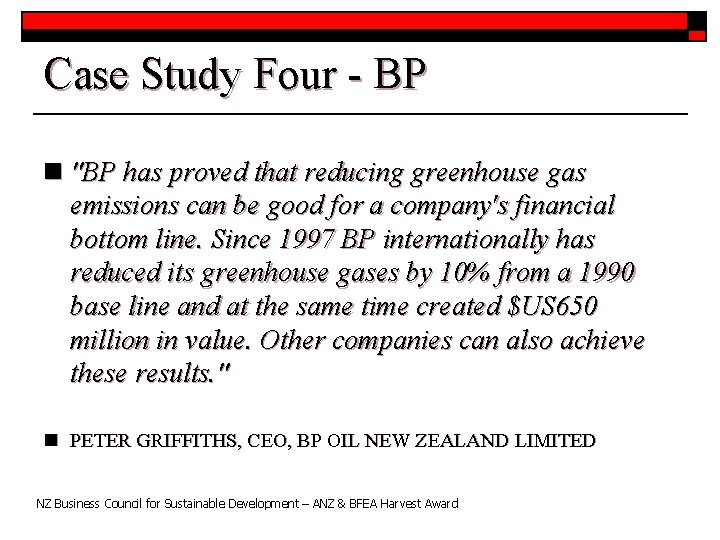
Case Study Four - BP n "BP has proved that reducing greenhouse gas emissions can be good for a company's financial bottom line. Since 1997 BP internationally has reduced its greenhouse gases by 10% from a 1990 base line and at the same time created $US 650 million in value. Other companies can also achieve these results. " n PETER GRIFFITHS, CEO, BP OIL NEW ZEALAND LIMITED NZ Business Council for Sustainable Development – ANZ & BFEA Harvest Award

So, Where are we Heading? n Companies living/breathing the need for sustainable business principles. n More links found between pollution and diseases – maybe as many as 200 from cerebral palsy to more than 37 types of cancer. n Greater government controls to manage sustainability – driven by voters n Shareholders demanding measures of “sustainability” in financial accounts
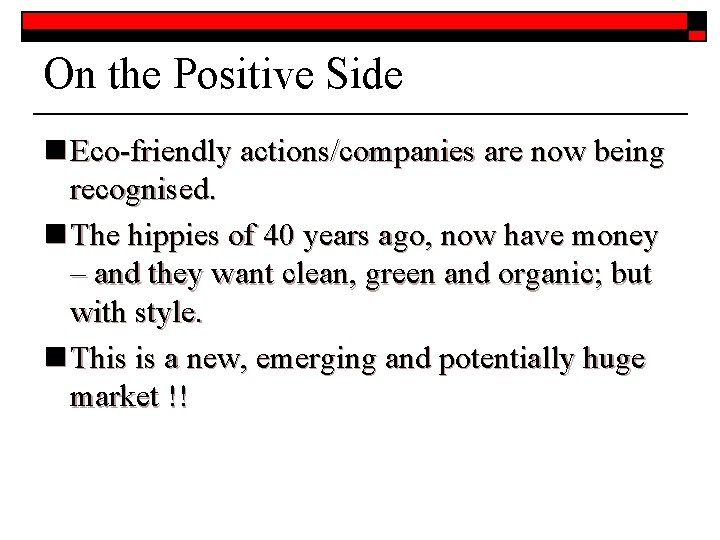
On the Positive Side n Eco-friendly actions/companies are now being recognised. n The hippies of 40 years ago, now have money – and they want clean, green and organic; but with style. n This is a new, emerging and potentially huge market !!

Quotes to remember n Dick Hubbard -If you're not sustainable yourself how can you demand it of others. n Ghandi - The world has enough for everyone’s needs but not for everyone’s greed. n Einstein - The world will not move beyond its current state of crisis using the same thinking that got us there in the first place.
- Slides: 62
